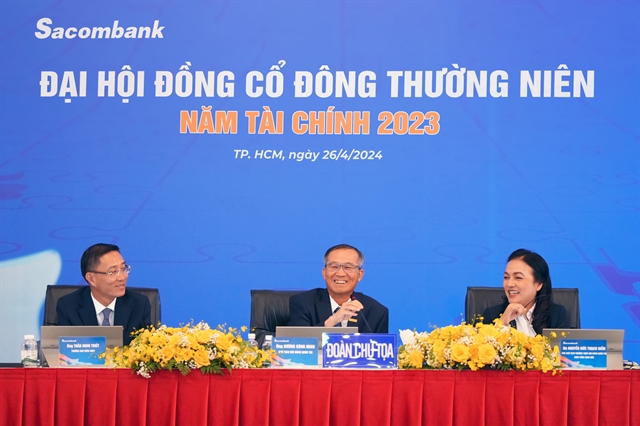 Talking Shop
Talking Shop

The Vietnamese economy’s bright prospects have created many opportunities for investors in the market. However, the economy is still heavily dependent on credit and the development of this market is still limited.
Vietnam News Agency talks to Vũ Bằng, member of the Prime Minister’s Economic Advisory Group, about how to make Việt Nam’s capital market become more attractive and what opportunities will be identified in 2018.
 |
| Vũ Bằng, member of the Prime Minister’s Economic Advisory Group. — VNA/VNS Photo Tuấn Anh |
The Vietnamese economy’s bright prospects have created many opportunities for investors in the market. However, the economy is still heavily dependent on credit and the development of this market is still limited.
Vietnam News Agency talks to Vũ Bằng, member of the Prime Minister’s Economic Advisory Group, about how to make Việt Nam’s capital market become more attractive and what opportunities will be identified in 2018.
Việt Nam’s economy has long been dependent on credit. According to experts, if firms depend almost entirely on credit, Việt Nam’s capital market will be unable to develop. What do you think about this?
Over the past five years, the capital market has helped mobilise about VNĐ1.4 quadrillion (US$61.9 billion) from issuing bonds and shares. On average, enterprises raised VNĐ20-30 trillion ($885 million - $1.3 billion) each year through the capital market.
However, the amount of credit [supplied by the monetary market] to the economy is still twice the funds provided by capital market.
There are a couple of reasons for the situation.
Firstly, previously, due to the impact of the global crisis, Việt Nam’s economy, as well as the production and business situation of listed companies, faced many difficulties. Therefore, firms did not call for capital by issuing shares and it would have been unlikely that the issuances would have succeeded.
Secondly, Vietnamese enterprises have for years been used to using loans rather than capital from shareholders. That habit comes mostly from State-owned enterprises which usually look for support from State capital sources and State-owned banks.
What do you think about the recent strong cash flow into the stock market from foreign investors?
The recent rally of the stock market is based on the fundamentals of the economy.
It is attributed to the recovery of the world stock market as well as the global economy, and the positive development of the country’s macro economy.
Equitisation which helps attract investors and strong foreign capital inflows have contributed to the market’s growth. In addition, the performance of businesses is generally better than before, which is evidenced by the surge of their revenues and profits.
After 10 years of restructuring, the stock market now has a better structure with a derivative market, and the completion of the stock and Government bond markets, as well as the preparation for the establishment of the corporate bond market. All these factors have enlarged the market scale.
The bigger the size of the market, the more the capital flows. These are the fundamental factors explaining the recent growth of the stock market.
What about the impact of restructuring the credit institution system and dealing with bad debt on the development of the capital market in Việt Nam?
These are two very closely related issues. With the recovery of the stock market, stock prices have also rebounded. Since then, dealing with bad debts is easier for commercial banks.
On the other hand, banks’ handling of bad debt also plays a very important role in the market. The debt recovery rate in 2017 was quite good. Banks’ bad debt ratio dropped to 7.9 per cent from 10.08 per cent. This has had a positive impact on banks’ credit quality, and hence the banks’ share prices, as well as the capital market.
Thanks to the restructuring process and bad debt handling, the performance of many bank stocks has improved and contributed to the growth of the stock market.
Could you assess the prospects for Việt Nam’s capital market in 2018?
In early February 2018, there were many factors harming the sustainability of capital flows and the Vietnamese capital market, such as the increase of US interest rates, the decline of the US market, the slump of the global stock market and rising global protectionism.
However, the capital market is still promising in 2018.
Our macro-economic situation last year was quite good in terms of growth, import-export and domestic demand.
The improvement of the business environment, labour productivity and the shift of the growth model has been a big focus of the Government, as a result, many solutions have been devised.
The process of dealing with bad debts and equitisation will also create an attractive capital market.
How can we attract and retain foreign funds in 2018?
In 2017, total indirect foreign capital inflows reached approximately $3 billion, more than double 2016’s figure, contributing to the market growth.
When our economy is open and integrating widely, the shift of foreign capital flows will impact on the capital market and the sustainability of the financial system.
Therefore, we need to take measures to maintain the long-term foreign indirect capital flows. The most basic factor is still the macroeconomic foundation.
We have to stabilise and develop the macro-economy, and stabilise the value of money and the interest rate, because the money value has a great impact on the calculations and investment decisions of foreign investors. — VNS









